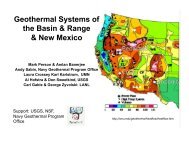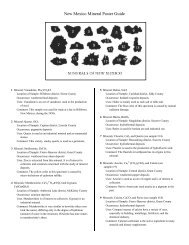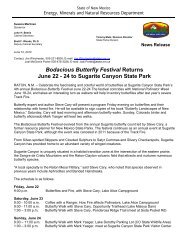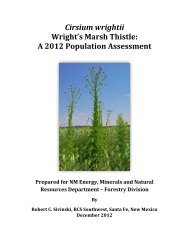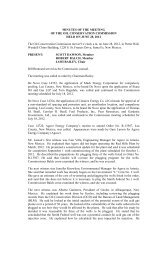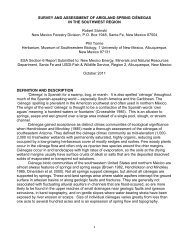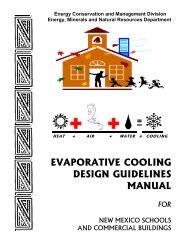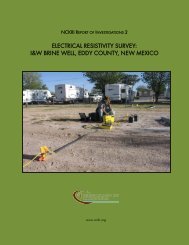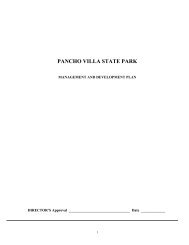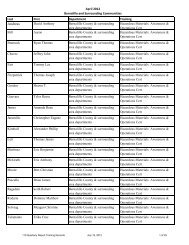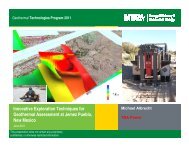Annual Report 3 - New Mexico - Energy, Minerals and Natural ...
Annual Report 3 - New Mexico - Energy, Minerals and Natural ...
Annual Report 3 - New Mexico - Energy, Minerals and Natural ...
Create successful ePaper yourself
Turn your PDF publications into a flip-book with our unique Google optimized e-Paper software.
58<br />
On a much smaller scale, cordwood boiler installations are increasingly popular for heating small buildings <strong>and</strong><br />
greenhouses throughout the state because of the technology’s simplicity <strong>and</strong> greater economics.<br />
Forestry, along with the State of Arizona, administers the Southwest Sustainable Forest Partnership (SWSFP). The<br />
SWSFP was created to develop value-added products from underutilized coniferous species in <strong>New</strong> <strong>Mexico</strong> <strong>and</strong><br />
Arizona. Traditionally, these species were characterized as being of a lower grade than other forest resources <strong>and</strong><br />
as having little economic value. The SWSFP’s goal is to develop an environmentally <strong>and</strong> economically sustainable<br />
forest <strong>and</strong> wood products industry utilizing small diameter materials removed during forest thinning <strong>and</strong> restoration<br />
treatments. The SWSFP is dedicated to addressing the ecological, economic <strong>and</strong> social effects of creating sustainable<br />
community <strong>and</strong> tribal-based forest <strong>and</strong> wood products enterprises in the Southwest.<br />
FIRE PLANNING TASK FORCE: The Forestry-led <strong>New</strong> <strong>Mexico</strong> Fire Planning Task Force (Task<br />
Force) facilitates the creation <strong>and</strong> implementation of Community Wildfire Protection Plans (CWPPs). CWPPs act<br />
as guides for wildfire prevention <strong>and</strong> preparedness for a single community or even an entire county. The plans identify<br />
hazardous fuels treatment areas <strong>and</strong> recommend measures to improve building codes for protection against wildfire<br />
<strong>and</strong> are developed collaboratively among community residents, community leaders <strong>and</strong> government agencies.<br />
Forestry provides consultation <strong>and</strong> follow-up training for the community leaders generating the plans. The<br />
Communities at Risk Assessment Plan identifies areas most vulnerable to wildfire. During 2010, the SWSFP added<br />
43 new communities to the list bringing the total number of at risk communities to 600. Two hundred <strong>and</strong> eightyone<br />
(281) communities are rated at high risk, 214 at moderate risk <strong>and</strong> 105 at low risk of wildl<strong>and</strong> fire. There are<br />
now 57completed CWPPs statewide.<br />
FIRE MANAGEMENT: 2010 was a relatively mild year for wildl<strong>and</strong> fire across much of the state.<br />
Thanks to plentiful winter <strong>and</strong> spring moisture, the number of wildfires <strong>and</strong> the subsequent acreage burned was<br />
down considerably from previous years. However, a lighter than usual return of monsoonal, or seasonal rainfall left<br />
the state with high fire danger for the fall <strong>and</strong> winter.<br />
For calendar year 2010, 411 fires burned approximately 55,868 acres on state <strong>and</strong> private l<strong>and</strong>. By way of<br />
comparison, during calendar year 2009, 735 fires burned approximately 373,372 acres. In fiscal year 2011, which<br />
began since July 1, 2010, there have been 176 fires that burned 12,129 acres. Wildl<strong>and</strong> fire incidents are reflected by<br />
the location map in the Data <strong>and</strong> Statistics section of this report.<br />
RESOURCE REHABILITATION AND PROTECTION: Forestry works with private<br />
l<strong>and</strong>owners, <strong>and</strong> state <strong>and</strong> federal agencies to protect l<strong>and</strong> from future development that could harm the l<strong>and</strong>scape.<br />
Through various incentive programs, l<strong>and</strong>owners can place large tracts of l<strong>and</strong> into conservation easements that allow<br />
them to retain ownership while protecting it.<br />
ENERGY, MINERALS AND NATURAL RESOURCES DEPARTMENT




